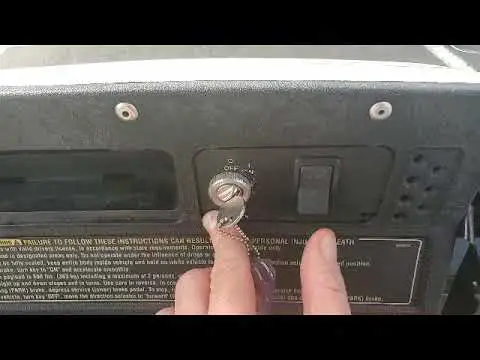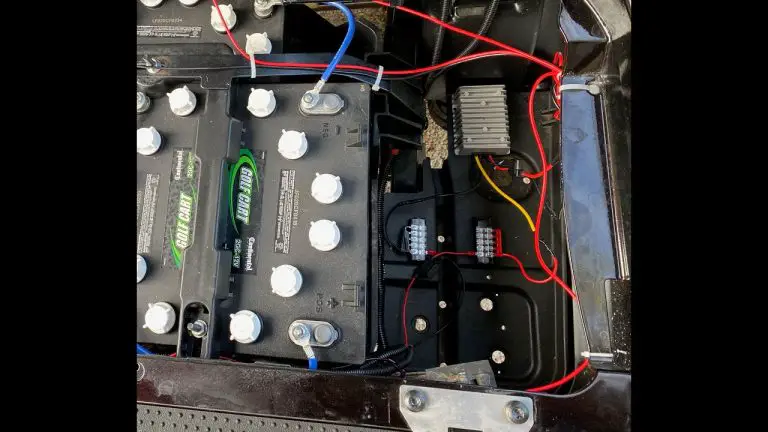How to Disable the Backup Alarm on a Golf Cart

Golf carts have become a popular mode of transportation in various settings, from golf courses to residential communities and recreational areas. While these electric vehicles offer convenience and versatility, the loud backup alarm can sometimes be a source of frustration or disturbance, especially in noise-sensitive environments. If you’re seeking a quieter golf cart experience or looking to comply with local noise regulations, disabling the backup alarm may be a viable option.
In this comprehensive guide, we will explore the process of disabling the backup alarm on a golf cart, ensuring a smooth and noise-free ride. We will address the reasons for disabling the alarm, legal considerations, alternative safety measures, and practical steps to modify your golf cart.
Understanding the importance of noise management, we will discuss the various situations where disabling the backup alarm is beneficial. Whether you reside in a noise-sensitive area or simply prefer a quieter ride, this guide will equip you with the knowledge and tools to disable the backup alarm safely and responsibly.
With a focus on contextually relevant information and step-by-step instructions, we will delve into the key aspects of disabling the backup alarm on a golf cart. By the end of this guide, you will have a clear understanding of the process, safety considerations, and alternative measures to ensure a quieter and more enjoyable golf cart experience.
So, let’s embark on this journey and learn how to disable the backup alarm on your golf cart, opening the door to a smoother, more peaceful ride on the fairways or in your community.

Why Disable the Backup Alarm on a Golf Cart?
Golf Cart Regulations and Noise Restrictions
Golf carts are subject to various regulations and noise restrictions, depending on the location and specific rules in place. Some areas may have noise limitations to ensure a peaceful environment for residents and visitors. Disabling the backup alarm can help you comply with these regulations while still enjoying your golf cart.
Noise Considerations in Residential Areas or Noise-Sensitive Environments
Residential areas, campgrounds, or other noise-sensitive environments often require minimizing disruptive sounds. The backup alarm’s loud beeping noise can be bothersome to nearby residents or wildlife. By disabling the backup alarm, you can maintain a more peaceful atmosphere without sacrificing the convenience of using your golf cart.
Personal Preference and Customization Options
Customizing your golf cart to your liking is part of the enjoyment for many owners. Disabling the backup alarm allows you to tailor the cart’s features to your personal preferences, creating a more enjoyable and personalized experience.
Familiarizing Yourself with the Golf Cart
Before diving into the process of disabling the backup alarm, it’s essential to familiarize yourself with your specific golf cart model and its components. Understanding the location and functionality of the backup alarm is crucial for a successful modification.
Types of Golf Carts and Their Features
Golf carts come in various models, each with its own unique features and design. Different manufacturers may position the backup alarm in different locations. Refer to your golf cart’s manual or contact the manufacturer to identify the specific location of the backup alarm on your model.
Locating the Backup Alarm on the Golf Cart
To disable the backup alarm, you need to know where it is located. Typically, the backup alarm is situated near the rear of the golf cart, close to the reversing mechanism. Consult your golf cart’s manual or manufacturer guidelines for precise instructions on locating the backup alarm.
Understanding the Alarm’s Functionality and Wiring
The backup alarm operates using electrical wiring connected to the cart’s power system. Before making any modifications, it’s essential to understand the alarm’s functionality and its wiring. This knowledge will help you make informed decisions during the disabling process.
Is Disabling the Backup Alarm Legal and Safe?
Disabling the backup alarm on a golf cart raises questions about the legality and safety of the modification. It’s important to consider local regulations, safety precautions, and alternative safety measures.
Local Regulations and Restrictions
Check the local regulations in your area regarding golf cart modifications. Some jurisdictions may have specific guidelines on modifying the alarm or restrictions on noise levels. Ensure that disabling the backup alarm complies with the rules and regulations in your location.
Safety Precautions and Alternative Safety Measures
The backup alarm serves as a safety feature, warning others of the golf cart’s movement in reverse. When disabling the alarm, it’s crucial to implement alternative safety measures to ensure the well-being of pedestrians and other golf cart users. Consider the following precautions:
- Installing a Rear-View Mirror: A rear-view mirror provides improved visibility when operating the golf cart in reverse. It allows you to monitor the surrounding area and take necessary precautions.
- Enhancing Visual Warnings: Attach brightly colored flags or signs to the rear of the golf cart to visually signal that the cart is in reverse. This additional visual cue can help alert others to the cart’s movement.
- Using Hand Signals or Verbal Communication: When operating the golf cart in reverse, use hand signals or verbal communication to indicate your intentions to pedestrians or other golf cart users. Clear and concise gestures or verbal cues can help ensure everyone’s safety.
Disabling the Backup Alarm
Now that you understand the reasons behind disabling the backup alarm and have familiarized yourself with the golf cart, it’s time to proceed with disabling the alarm. Follow these steps to disable the backup alarm:
- Review the Golf Cart’s Manual or Manufacturer Guidelines: Consult your golf cart’s manual or reach out to the manufacturer for specific instructions on disabling the backup alarm. They may provide guidance on disconnecting the wiring or modifying the alarm’s circuit.
- Disconnect the Backup Alarm’s Wiring: Locate the wiring connected to the backup alarm. Depending on the cart’s make and model, the wiring may be accessible from the rear or underneath the cart. Carefully disconnect the wiring from the alarm, ensuring that it won’t interfere with any other electrical components.
- Modifying the Alarm’s Circuit or Volume Control: Some golf carts may offer options to modify the backup alarm’s circuit or adjust its volume control. Refer to the manual or manufacturer guidelines for instructions on making these modifications. Keep in mind any legal or safety considerations while adjusting the alarm’s settings.
Remember, disabling the backup alarm is a personal choice that should be made responsibly and in compliance with local regulations. Always prioritize safety and consider alternative safety measures to compensate for the disabled alarm.
Alternative Solutions for Quieter Reverse Operation
While disabling the backup alarm may be necessary in certain situations, it’s important to maintain safety during reverse operation. Consider implementing alternative solutions to ensure a safe and quiet experience. Here are some options to explore:
- Installing a Backup Camera or Sensor System: Installing a backup camera or sensor system provides visual or audible cues to assist with reversing. These systems can help you identify obstacles and ensure safe maneuvering without relying solely on the backup alarm.
- Implementing Visual Warning Signs or Flags: As mentioned earlier, attaching bright flags or signs to the rear of the golf cart alerts others to your presence and movement. These visual warnings serve as a substitute for the backup alarm and help maintain safety.
- Using Hand Signals or Verbal Communication: Clear hand signals or verbal communication can effectively indicate your intention to move in reverse. Make sure to communicate your actions clearly and look for acknowledgment from pedestrians or other golf cart users before proceeding.
Reversing Safety Practices without the Backup Alarm
With the backup alarm disabled, it’s crucial to adopt safe reversing practices to prevent accidents and maintain the well-being of those around you. Here are some best practices to follow:
- Enhance Awareness and Vigilance: Remain alert and attentive while operating the golf cart in reverse. Continuously scan the surrounding area for potential obstacles or pedestrians, and be prepared to take evasive action if necessary.
- Check Surroundings and Use Mirrors: Before initiating reverse movement, perform a thorough visual check of your surroundings. Use side mirrors, if available, to expand your field of view and ensure there are no immediate hazards in your path.
- Develop Safe Driving Habits and Defensive Driving Techniques: Adopt safe driving habits and defensive driving techniques to minimize the likelihood of accidents. Maintain a reasonable speed, avoid distractions, and be prepared to react to unexpected situations.
Maintenance and Professional Assistance
Regular maintenance of your golf cart is essential for its overall performance and longevity. While disabling the backup alarm may not directly affect maintenance, it’s important to stay proactive. Consider the following:
- Regular Inspection and Maintenance of the Golf Cart: Conduct routine inspections of your golf cart to ensure all components are functioning correctly. Check the electrical system, wiring connections, and other vital parts to maintain overall safety and reliability.
- Consulting with a Golf Cart Technician or Expert:
If you have any concerns or questions about disabling the backup alarm or maintaining your golf cart, it’s advisable to consult with a golf cart technician or expert. These professionals have the knowledge and experience to provide valuable guidance and assistance. They can offer insights specific to your golf cart model and help ensure that any modifications or maintenance procedures are carried out safely and in compliance with regulations.
It’s also important to understand any warranty or legal implications associated with modifying your golf cart. Consult the manufacturer or review the warranty documentation to determine how disabling the backup alarm may affect your coverage. Additionally, familiarize yourself with local laws and regulations to ensure that your modified golf cart remains compliant.
Conclusion
Disabling the backup alarm on your golf cart can be a practical solution in certain situations, such as noise-sensitive environments or when personal preferences require customization. By understanding the reasons for disabling the alarm, following proper procedures, and implementing alternative safety measures, you can maintain a safe and enjoyable golf cart experience.
Always prioritize safety and comply with local regulations and guidelines when making modifications to your golf cart. Consult the golf cart’s manual, manufacturer guidelines, and seek professional assistance if needed. By taking these steps, you can strike a balance between a quieter ride and ensuring the well-being of others while operating your golf cart in reverse.






